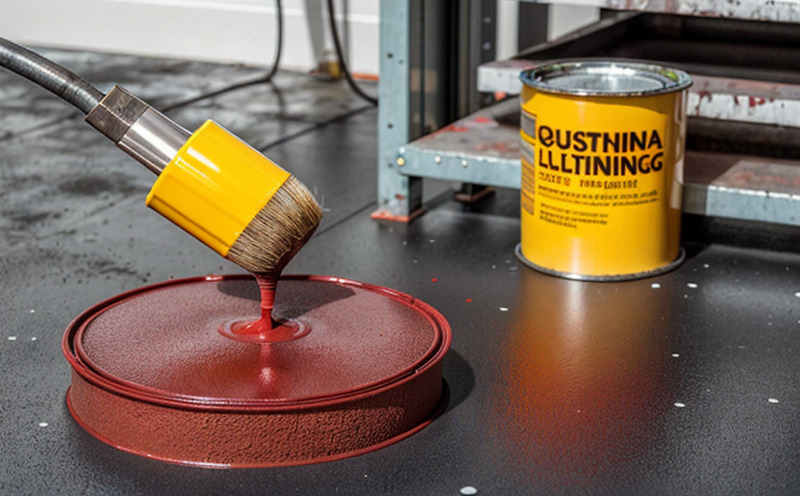ISO 8502 Surface Contamination Testing before Coating
The ISO 8502 standard is a cornerstone in ensuring quality and reliability of industrial coatings by providing precise methods for measuring the cleanliness of surfaces prior to coating. This service focuses on the specific requirements outlined in ISO 8502-1, ISO 8502-2, and ISO 8502-4 for assessing surface contamination levels using various techniques.
The importance of this testing cannot be overstated. Contamination on the surface can lead to poor adhesion between the coating and the substrate, reduced durability, and even premature failure of coatings in harsh industrial environments. By ensuring that surfaces are free from contaminants such as oil, grease, water marks, or other residues before applying a coat of paint or other protective finishes, ISO 8502 testing helps manufacturers maintain high standards of product integrity.
The process involves several steps. Initially, the surface to be coated is cleaned in accordance with the specified protocol. Once clean, it undergoes inspection using non-destructive methods such as magnetic particle testing (MPT), visual examination, or ultrasonic testing if specified by the ISO standard being followed. The aim here is to identify any remaining residues that might affect subsequent coating processes.
For instance, in the case of MPT, small particles are applied to the surface which will gather around areas where there is contamination. This makes it easier for inspectors to locate and quantify these contaminants before proceeding with the application of a new coat. Visual inspection may also involve using specialized lighting techniques or magnification tools to detect minute traces that might not be visible under normal conditions.
Once identified, further cleaning steps are taken if necessary until all detected contaminants have been removed according to the required standards. After thorough cleaning and drying (if applicable), another inspection is carried out to confirm that no residues remain on the surface. Only then can a suitable coating material be applied, ensuring optimal adhesion properties and longevity of protection provided by the finish.
The ISO 8502 methodology ensures consistent results across different facilities, which is crucial for maintaining quality control in industrial manufacturing processes. It provides clear guidelines about what constitutes acceptable levels of surface cleanliness based on factors like the type of coating being used, environmental conditions during application, and expected service life of the product.
Implementing this testing procedure early in your production line helps prevent costly rework later down the road due to poor initial adhesion caused by residual contaminants. Additionally, it enhances customer satisfaction by delivering products that meet strict quality standards set forth by international bodies like ISO.
Scope and Methodology
The scope of our ISO 8502 service includes conducting thorough inspections on various types of industrial surfaces before they receive any form of protective coating. We utilize state-of-the-art equipment tailored to meet the stringent requirements outlined in the relevant sections of ISO 8502.
For magnetic particle testing (MPT), we employ high-intensity magnetizers capable of generating strong fields necessary for detecting even trace amounts of contamination beneath the surface. Our team is equipped with advanced lighting systems and magnifying glass tools to enhance visibility during visual inspections, ensuring no detail goes unnoticed.
The methodology also encompasses detailed documentation practices where all findings are meticulously recorded alongside images and videos if required by clients or regulatory bodies. This comprehensive record-keeping process not only aids in tracking progress but also serves as valuable reference material for future audits or troubleshooting purposes.
Industry Applications
The application of ISO 8502 surface contamination testing before coating extends across multiple industries where maintaining high standards of quality is paramount. In automotive manufacturing, for example, ensuring that the metal components are free from any form of dirt or grease ensures better adhesion between primer and final paint layers, leading to longer-lasting finishes.
In aerospace engineering, cleanliness plays a critical role in preventing corrosion and extending the operational lifespan of aircraft parts. By adhering strictly to ISO 8502 protocols during pre-coating stages, manufacturers can guarantee that their products meet stringent safety standards set forth by aviation authorities worldwide.
The oil and gas sector also benefits greatly from this type of testing as it helps protect equipment against degradation caused by environmental factors such as saltwater exposure or chemical spills. Properly cleaned surfaces enhance the performance capabilities of pipelines, storage tanks, and other critical infrastructure elements within this industry.
Use Cases and Application Examples
A common use case involves checking steel structures in industrial settings before applying protective coatings. For instance, a bridge construction company might require our services to ensure that the structural components are free from dust particles or other foreign materials prior to painting operations.
In another scenario, an electronics manufacturer may need ISO 8502 testing for circuit boards that will be subjected to harsh operating environments such as outdoor installations. By ensuring these surfaces comply with ISO standards, they can avoid potential short circuits resulting from microscopic contaminants interfering with electrical connections.
Another example includes checking the inside of storage tanks in petrochemical plants where even minimal amounts of contamination could lead to severe operational issues if not addressed early on. Our team would conduct rigorous inspections using appropriate tools and techniques specified by ISO 8502 guidelines before recommending further cleaning actions as needed.





